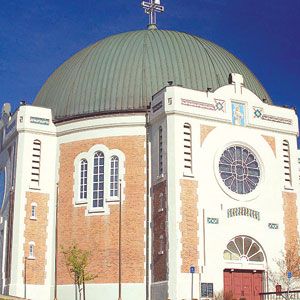As Dudemaine wrote in his memoirs: “Bishop Lachance came to me and said, ‘It is a diocese that I’ve sent you to prepare’ and I saw my duty more clearly... One day I will build a cathedral.”
To say the least, that was an ambitious plan. The first Mass in the area had only been celebrated three years earlier, on the feast of St. Teresa of Avila, in the home of a parishioner. But in 1922 construction began on what would become one of the most beautiful houses of worship in North America, the Cathedral of St. Teresa of Avila.
Under the direction of architect Aristide Beaugrand-Champagne, the church was built in the Roman-Byzantine style, then unknown in North America. It featured a circular design with a large dome that, at the time, journalists predicted would some day collapse. Just as novel, however, was the use of reinforced concrete to ensure the building was never destroyed by the area’s frequent forest fires. This proved economical as well. The cost was $150,000 and construction was completed in just 16 months, due largely to the efforts of townspeople who received 10 cents an hour to assist the construction crews in the evening.
The church, located near the junction of the Transcontinental Railway and the Harricana River, was completed in 1923, just nine years after Dudemaine first conceived his plan. This was unheard of in an area newly opened for settlement and for a town not yet 10 years old.
As the years went on, the townspeople helped pay to furnish the interior of their impressive new church, a building that rose 10 stories high and was 50 metres long. They purchased adornments such as stained glass windows from France and gold leaf mosaics from Italy. In 1953, a state-of-theart Casavant organ was installed. Other additions included an anodized aluminium cross atop the dome, exterior mosaic facades of Sts. Teresa, Joseph, John and Viateur, erection of a Glorified Christ sculpture in the sanctuary and installation of an electronic carillon.
In 1939, the diocese of Amos was established and the town’s church was elevated to the status of cathedral. It was designated a provincial heritage site in 2003.
To witness the splendour of the cathedral today is an overpowering experience: the grand interior bathed in soft light; the pews, hewn of finest oak, that can accommodate 1,200 worshippers. Drawn by two dozen columns rising from floor to ceiling, one’s eyes are taken to the huge dome. In its centre is a dove, representing the Holy Spirit, surrounded by 24 sculpted rosettes. (Under the dove are inscribed the names of those who worked on it.) A visitor’s eyes are then drawn to the simple sanctuary, with its marble altar. A large mosaic made of Italian ceramic tiles with gold powder depict St. Teresa of Avila on the wall behind the altar. Above is a silver cross. There are two mosaics on the side walls depicting the baptism of Jesus and the Annunciation, as well as the Stations of the Cross of the same material. On three sides of the church are the stunning stained glass windows from France. A large wall motto invites: Venez — Dieu Nous Appelle (Come — God Calls Us).
Don’t miss touring the basement area of the church. There is a crypt containing the remains of the first bishop, J. Aldee Desmarais, and one-time Amos mayor M. Hector Authier. Also on display in the lower level are photos reflecting the life of the parish, including those of annual Christmas creches since 1923. Also here is the exquisite Chapel of the Sacred Heart, with its painting of Christ appearing to St. Margaret Mary. The chapel decorations are outstanding — wooden sculptures by Rene Thibault and mosaics by Marcel Gagnon, each unique in its symbolic Gospel message. This chapel is surely an artistic, as well as a spiritual, experience.
In 2014 Amos will be 100 years old, and great celebrations are planned. It would be a good time to visit one of its prime attractions, the Cathedral of St. Teresa of Avila.
Contact www.ville.amos.qc.ca or 1-800-670-0499.
(O’Donnell Williams is a freelance writer in Markham, Ont.)


